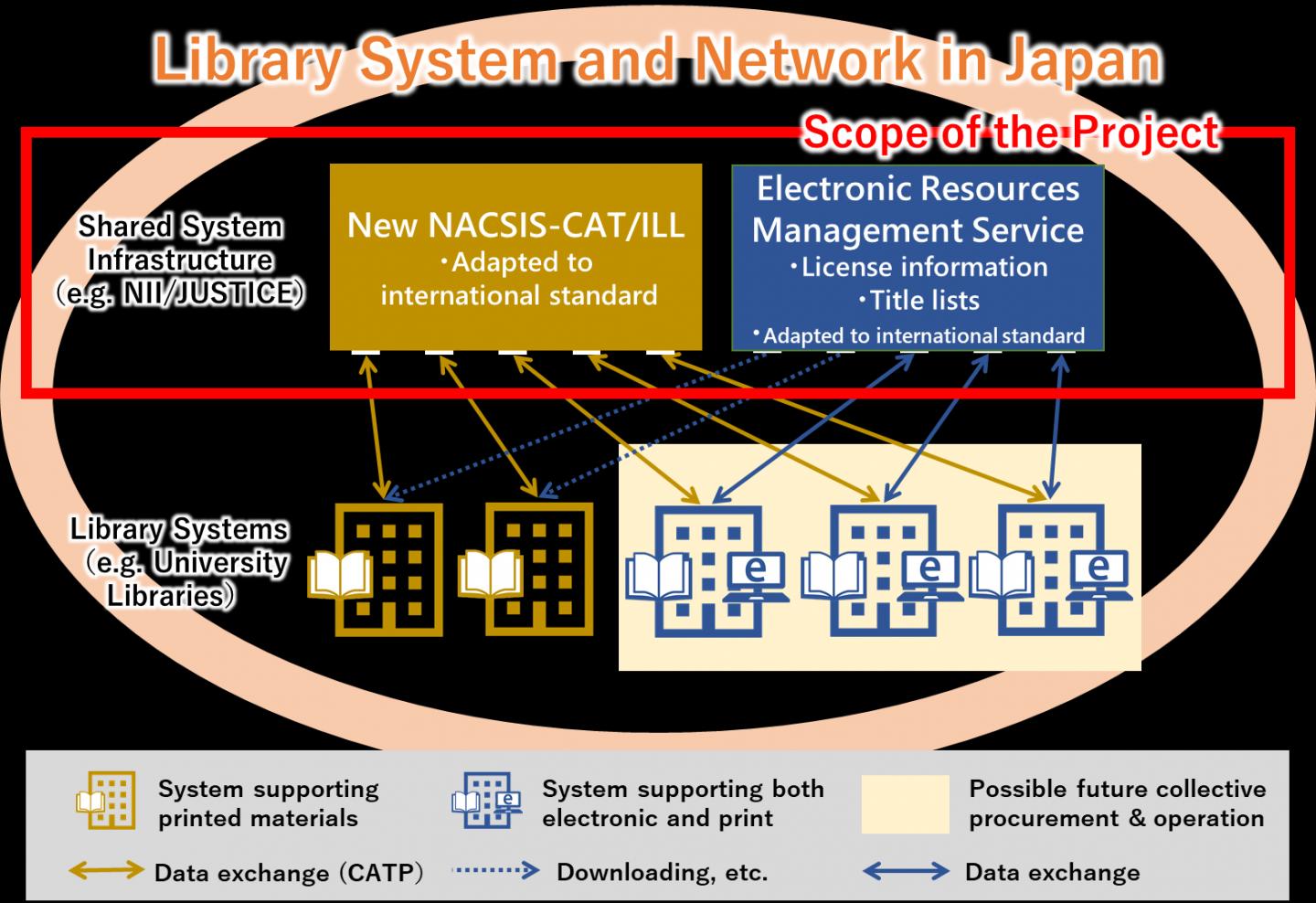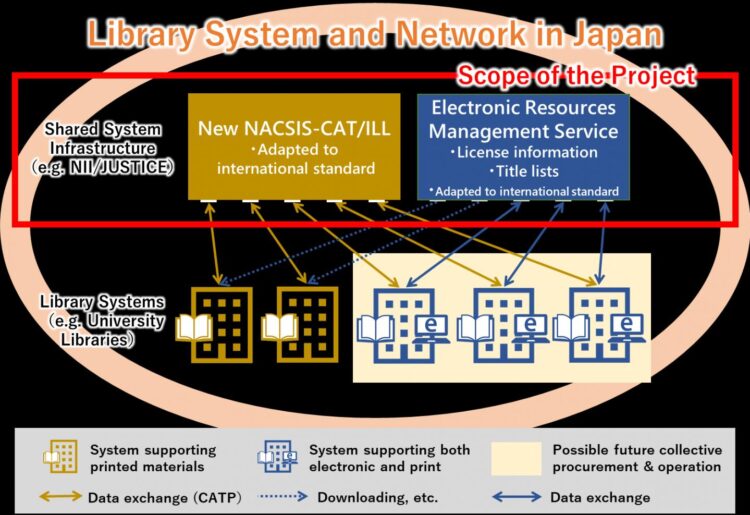New catalog information service corresponding to digital resources to be introduced from 2022

Credit: © National Institute of Informatics
National Institute of Informatics (NII; Director General: Dr. KITSUREGAWA Masaru, Tokyo, Japan) has begun reconstruction of NACSIS-CAT/ILL, a catalog information service used by more than 1,300 institutions, mainly university libraries.
This project is based on “The Vision on Future Scholarly Information Systems (2019)”, which was published by the Future Scholarly Information Systems Committee*1 under the Council for Promoting Collaboration between University Libraries and the National Institute of Informatics*2. The project will be implemented by coordinating with library systems of the user libraries, with a view to establishing a library system and network which will handle digitized resources, such as electronic journals and eBooks (Figure 1).
The new electronic resource management service will be released in 2022, and the new NACSIS-CAT/ILL is expected to be launched in 2023. These new systems will contribute to the improvement and optimization of university library operations, and the digital transformation of access to academic resources (Figure 2).
Background
A catalog information service, NACSIS-CAT/ILL, develops a union catalog covering the resources held by university libraries and facilitates the interlibrary loan. It was a core business launched by the National Center for Science Information Systems (NACSIS), the predecessor of NII, in 1985. As of March 2021, it has 1,336 user institutions, 13 million bibliographic records, and 147 million holding records, assisting researchers and students with finding academic resources. Recently, the methods of resource management and distribution have been changing dramatically, due to the diffusion of digitized academic resources (electronic journals, eBooks, databases, collectively electronic resources). There was a pressing need to embrace the increased usage of digital academic resources among researchers and students, and a new system has been awaited.
New systems
In the existing model, NII provided the central system, and user libraries had linked their library systems to it through NII’s original MARC format CATP. The central system was used for creating a union catalog and for interlibrary loan, mainly covering print materials.
“The Vision on Future Scholarly Information Systems (2019)”, submitted by the Future Scholarly Information Systems Committee, proposed a new library system and network that handle electronic resources, and print materials seamlessly on the cloud environment (Figure 1). This project covers the “New NACSIS-CAT/ILL” and the “Electronic Resources Management Service” of the proposed library system and network.
To support continuous utilization and to accommodate emerging needs, the new system will adopt the international standard package systems and handle electronic resources. In addition, it is expected to lead to the advancement of the university library’s functions and the optimization of system operations by the collective procurement and operation of library systems, which is currently being discussed by the Future Scholarly Information Systems Committee.
Functionalities
*The new electronic resource management system will accumulate and provide common data such as license terms and title lists for electronic resource products submitted by domestic and foreign publishers and academic societies to the Japan Alliance of University Library Consortia for E-Resources (JUSTICE*3).
*The new NACSIS-CAT/ILL system will provide capabilities to adapt to the new international standards such as the Resource Description and Access (RDA), Nippon Cataloging Rules?NCR?2018 edition, and BIBFRAME.
*It will maintain the current functionalities of NACSIS-CAT/ILL in order to secure the continuity of connections with the library systems used by the 1,300 user institutions.
Base systems
For the development of the new system, the following package systems will be utilized as base systems, and new functionalities required by Japanese users will be added. Kinokuniya Company Ltd. (Chairman and President: TAKAI Masashi, Tokyo, Japan) will be a contractor for the provision of these package systems.
1.The new NACSIS-CAT/ILL System will utilize the Controlled Bibliographic Service (CBS) of an American organization, OCLC, as its base. CBS was designed for cooperative cataloging and interlibrary loan, and it is widely used in European countries such as the United Kingdom, the Netherlands, Germany, France, and also Australia. In this plan, CBS will support the existing CATP format to exchange the MARC records with the user libraries. On the other hand, the bibliographic data in the underlying system is compliant with the international standard MARC21, allowing for an easy exchange of the metadata distributed internationally with overseas institutions. CMS Co. Ltd., a Japanese system company, will develop the interlibrary loan system, which works with CBS seamlessly.
2.For the new electronic resource management service, Alma by Ex Libris will be used. With an increase in digital resources, it is critical to find ways to effectively manage electronic resources and develop a research environment. Alma has been introduced to a great number of universities and consortia throughout the world as a resource management platform in the digital era. With the new electronic resource management system based on Alma, libraries across Japan will be able to access content and license information of electronic resources.
###
Related links
*NACSIS-CAT/ILL Catalog Information Service | https:/
*Press release from Kinokuniya Company Ltd | https:/
*Press release from OCLC | https:/
*Press release from Ex Libris | https:/
(*1) The Future Scholarly Information Systems Committee was formed under the Council for Promoting Collaboration between University Libraries and the National Institute of Informatics. The committee is in charge of planning for “Enhancement of a union catalog database covering electronic information resources” and advancement of activities for collective development, management, sharing, and provision of the infrastructure of the academic information resources. For further information, please visit: https:/
(*2) The Council for Promoting Collaboration between University Libraries and the National Institute of Informatics was established with an aim to further improve the procurement and transmission of academic information that is vital for academic institutions such as universities in Japan. This committee contributes to facilitate the collaboration between national, public, and private universities and NII. For further information, please visit: https:/
(*3) The Japan Alliance of University Library Consortia for E-Resources (JUSTICE) was created under the Council for Promoting Collaboration between University Libraries and the National Institute of Informatics, and promotes the procurement of electronic journals including backfiles and maintenance of system to secure the perpetual access to the resources. For further information, please visit: https:/
About the National Institute of Informatics (NII)
NII is Japan’s only academic research institute dedicated to the new discipline of informatics. Its mission is to “create future value” in informatics. NII conducts both long-term basic research and practical research aimed at solving social problems in a wide range of informatics research fields, from fundamental theories to the latest topics, such as artificial intelligence, big data, the Internet of Things, and information security.
As an inter-university research institute, NII builds and operates academic information infrastructure essential for the research and educational activities of the entire academic community (including the Science Information Network) as well as developing services such as those that enable the provision of academic content and service platforms. https:/
About the Research Organization of Information and Systems (ROIS)
ROIS is a parent organization of four national institutes (National Institute of Polar Research, National Institute of Informatics, the Institute of Statistical Mathematics and National Institute of Genetics) and the Joint Support-Center for Data Science Research. It is ROIS’s mission to promote integrated, cutting-edge research that goes beyond the barriers of these institutions, in addition to facilitating their research activities, as members of inter-university research institutes.
Media Contact
(Mr.)Takao Fujiyoshi
[email protected]
Original Source
http://www.





